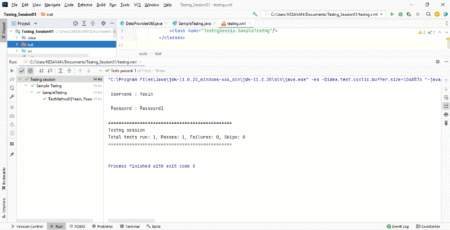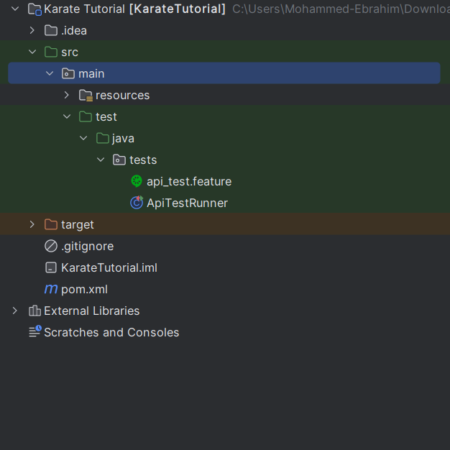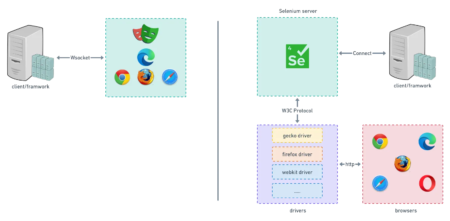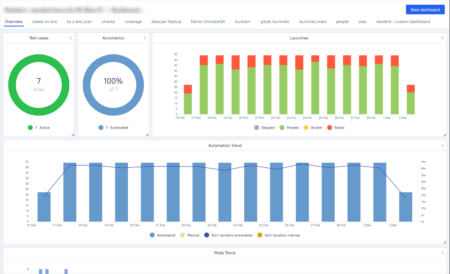Introduction In today’s digital world, security is paramount, especially when dealing with sensitive data like user authentication and financial transactions.…
Software Engineering
package uytr;
import java.awt.Point;
import org.openqa.selenium.By;
import org.openqa.selenium.Keys;
//import org.openqa.selenium.By;
//import org.openqa.selenium.Keys;
import org.openqa.selenium.WebDriver;
import org.openqa.selenium.WebElement;
import org.openqa.selenium.chrome.ChromeDriver;
import org.openqa.selenium.support.ui.Select;
public class Abi {
public static void main(String[] args) {
//System.setProperty(“webdriver.chrome.driver”, “C:UsersdhanaDownloadschromedriver-win64chromedriver-win64.exe”);
WebDriver driver=new ChromeDriver();
driver.get(“https://www.leafground.com/select.xhtml;jsessionid=node01o9qlws6megijfidmkoq8n2j0425439.node0”);
//driver.findElement(By.linkText(“Go to Dashboard”)).click();
WebElement sukanya= driver.findElement(By.className(“ui-selectonemenu”));
Select veera=new Select(sukanya);
String a=(String)veera.selectByVisibleText(“Playwright”);
System.out.println(a);
}
}
Selenium has become a go-to tool for automating web application testing. But automation isn’t just about running tests it’s also about understanding the results. That’s where Selenium Report Generation plays a crucial role. Good test reports help teams track progress, spot issues, and improve the quality of their software. Selenium supports various tools that turn
The post Selenium Report Generation: A Detailed Analysis appeared first on Codoid.
The blog discusses how AI-powered performance testing automates and enhances system optimization by identifying bottlenecks, improving accuracy, and accelerating delivery. Read the blog to learn how Tx can help you upscale your performance testing efforts.
The post 5 Business Benefits of Investing in AI-Powered Performance Testing first appeared on TestingXperts.
Modern software systems are highly interconnected and increasingly complex bringing with them a greater risk of unexpected failures. In a world where even brief downtime can result in significant financial loss, system outages have evolved from minor annoyances to critical business threats. While traditional testing helps catch known issues, it often falls short when it
The post Chaos Testing Explained appeared first on Codoid.
In the ever-evolving world of software development, efficiency and speed are key. As projects grow in complexity and deadlines tighten, AI-powered tools have become vital for streamlining workflows and improving productivity. One such game-changing tool is JetBrains AI Assistant a powerful feature now built directly into popular JetBrains IDEs like IntelliJ IDEA, PyCharm, and WebStorm.
The post JetBrains AI Assistant : Revolutionizing Tech Solutions appeared first on Codoid.
The blog discusses how cloud-native architecture empowers DevOps teams with scalable, resilient, and automated workflows. By overcoming traditional challenges like rigid infrastructure and slow-release cycles, it enables faster innovation through microservices, containers, and CI/CD tools.
The post How Can Cloud-Native Architecture Enhance Your DevOps Practices first appeared on TestingXperts.
The blog discusses the importance of high-quality data in today’s AI-first world. Poor data quality can break even the most intelligent systems. This blog explores how enterprises can avoid costly failures and unlock the full potential of their AI investments through enterprise-grade data quality management (DQM).
The post Turn Data Chaos into AI Clarity with Data Quality Management first appeared on TestingXperts.
The blog discusses how Intelligent Automation reshapes manufacturing by optimizing production, improving quality, and reducing operational costs. From predictive maintenance to real-time decision-making, IA enhances efficiency, minimizes downtime, and streamlines supply chains.
The post Modern Manufacturing’s Silent Revolution: Intelligent Automation first appeared on TestingXperts.
Performance testing for web and mobile applications isn’t just a technical checkbox—it’s a vital process that directly affects how users experience your app. Whether it’s a banking app that must process thousands of transactions or a retail site preparing for a big sale, performance issues can lead to crashes, slow load times, or frustrated users
The post Challenges of Performance Testing: Insights from the Field appeared first on Codoid.
Automation testing is essential in today’s software development. Most people know about tools like Selenium, Cypress, and Postman. But many don’t realize that Spring Boot can also be really useful for testing. Spring Boot, a popular Java framework, offers great features that testers can use for automating API tests, backend validations, setting up test data,
The post Spring Boot for Automation Testing: A Tester’s Guide appeared first on Codoid.
Artificial intelligence (AI) is transforming software testing, especially in test case generation. Traditionally, creating test cases was time-consuming and manual, often leading to errors. As software becomes more complex, smarter and faster testing methods are essential. AI helps by using machine learning to automate test case creation, improving speed, accuracy, and overall software quality. Not
The post AI Generated Test Cases: How Good Are They? appeared first on Codoid.
The blog discusses why Workday testing is essential for smooth HR and finance operations, ensuring accuracy, compliance, and efficiency. It enhances user experience, improves data accuracy, and reduces compliance risks, making business processes more reliable and efficient.
The post Workday Testing: The Smart Move for Scalable Business Growth first appeared on TestingXperts.
The blog discusses how retail automation transforms businesses by optimizing inventory, reducing errors, and enhancing customer experiences. From AI-driven fraud detection to seamless checkout solutions, automation boosts efficiency and profitability. This blog explores the top benefits and real-world use cases that help retailers stay competitive in the evolving digital landscape.
The post Top 5 Benefits of Retail Automation for Modern Business Success first appeared on TestingXperts.
API testing is a crucial component of modern software development, as it ensures that backend services and integrations function correctly, reliably, and securely. With the increasing complexity of distributed systems and microservices, validating API responses, performance, and behavior has become more important than ever. The Karate framework simplifies this process by offering a powerful and
The post Karate Framework for Simplified API Test Automation appeared first on Codoid.
I don’t know if this is the right place to ask, but StackOverflow seems to only accept coding related questions, so this is the next best place I can find.
In UX Design, there is the concept of ‘deceptive pattern’ where the user can be intentionally led to do something that may be harmful to them without their knowledge. Of course, this surfaces as a design decision that is implemented in code and on the interface (which drives the user’s actions).
However, I read this example about Grammarly’s Browser Extension implementation, where some code is inserted without user knowledge that impacts the way the website or application behaves. So I wonder if there is an equivalent of this in coding (i.e. a deceptive programming) that can be picked up through normal software testing processes? Is this an area of research and practice in software QA?
Playwright is a fast and modern testing framework known for its efficiency and automation capabilities. It is great for web testing, including Playwright Mobile Automation, which provides built-in support for emulating real devices like smartphones and tablets. Features like custom viewports, user agent simulation, touch interactions, and network throttling help create realistic mobile testing environments
The post Playwright Mobile Automation for Seamless Web Testing appeared first on Codoid.
I am using Robot framework to automate a file upload to a webpage. I am using the Choose File keyword.
Code notes: ${CONTINUE_BUTTON} is a button at the bottom of the screen, ensuring that the entire bottom of the webpage is visible. The Sleeps are there temporarily so that I know it’s not a timing issue and can watch the automation as it happens.
”’
${uploadFileButton} = xpath://*[@id=”67e21641-340b-4f15-94e2-e5ab7a8532a1″]/div/button
${testDoc} = C:UsersjasonbDocumentsDummyDocumentsTestDocument.pdf
Scroll Element Into View ${CONTINUE_BUTTON}
Sleep 10s
Wait Until Element Is Visible ${uploadFileButton}
Choose File ${uploadFileButton} ${testDoc}
Sleep 10s
”’
I ensured that the Xpath locator is the correct one by searching it in my inspect panel. In the failure screenshots, the button is visible.
When I use the Wait Until Element Is Visible keyword, I get this error:
”’
Element ‘xpath://*[@id=”67e21641-340b-4f15-94e2-e5ab7a8532a1″]/div/button’ not visible
after 5 seconds.
”’
When I don’t use the Wait Until Element is Visible keyword, I get this error:
”’
Element with locator ‘xpath://*[@id=”67e21641-340b-4f15-94e2-e5ab7a8532a1″]/div/button’
not found.
”’
I also tried using a different element that is not the clickable part of the upload file button:
”’
${uploadFileButton} = xpath://*[@id=”67e21641-340b-4f15-94e2-e5ab7a8532a1″]/div/button
”’
And got this error:
”’
Element with locator ‘xpath://*[@id=”67e21641-340b-4f15-94e2-e5ab7a8532a1″]’ not
interactable.
”’
So it can see the non-clickable element, but not the clickable element just a few HTML lines down from it. What is happening here?
The blog discusses how multimodal AI is upscaling the financial sector by integrating diverse data sources to enhance fraud detection, risk management, and customer interactions. From algorithmic trading to real-time market predictions, this technology is shaping the future of finance. Explore its applications, challenges, and the latest trends driving its rapid adoption.
The post Is Multimodal AI in Finance the Next Strategic Move for Growth? first appeared on TestingXperts.
Ensuring high-quality software requires strong testing processes. Software testing, especially test automation, is very important for this purpose. High test coverage through automation test coverage metrics shows how much automated tests are used in testing a software application. This measurement is key for a good development team and test automation. When teams measure and analyze
The post Automation Test Coverage Metrics for QA and Product Managers appeared first on Codoid.










